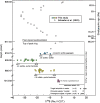Microbial Sulfur Isotope Fractionation in the Chicxulub Hydrothermal System
- PMID: 33124879
- PMCID: PMC7826424
- DOI: 10.1089/ast.2020.2286
Microbial Sulfur Isotope Fractionation in the Chicxulub Hydrothermal System
Abstract
Target lithologies and post-impact hydrothermal mineral assemblages in a new 1.3 km deep core from the peak ring of the Chicxulub impact crater indicate sulfate reduction was a potential energy source for a microbial ecosystem (Kring et al., 2020). That sulfate was metabolized is confirmed here by microscopic pyrite framboids with δ34S values of -5 to -35 ‰ and ΔSsulfate-sulfide values between pyrite and source sulfate of 25 to 54 ‰, which are indicative of biologic fractionation rather than inorganic fractionation processes. These data indicate the Chicxulub impact crater and its hydrothermal system hosted a subsurface microbial community in porous permeable niches within the crater's peak ring.
Keywords: Chicxulub.; Hydrothermal; Impact crater; Origin of life.
Figures




References
-
- Abramov O., and Kring D.A. (2004) Numerical modeling of an impact-induced hydrothermal system at the Sudbury crater. J Geophys Res 109, doi:10.1029/2003JE002213 - DOI
-
- Abramov O., and Kring D.A. (2005) Impact-induced hydrothermal activity on early Mars. J Geophys Res 110, doi:10.1029/2005JE002453 - DOI
-
- Abramov O., and Kring D.A. (2007) Numerical modeling of impact-induced hydrothermal activity at the Chicxulub crater. Meteorit Planet Sci 42:93–112
-
- Alain K., Postec A., Grinsard E., Lesongeur F., Prieur D., and Godfroy A. (2010) Thermodesulfatator atlanticus sp. nov., a thermophilic, chemolithoautotrophic, sulfate-reducing bacterium isolated from a Mid-Atlantic Ridge hydrothermal vent. Int J Syst Evol Microbiol 60:33–38 - PubMed
-
- Alazard D., Dukan S., Urios A., Verhé F., Bouabida N., Morel F., Thomas P., Garcia J.-L., and Ollivier B. (2003) Desulfovibrio hydrothermalis sp. nov., a novel sulfate-reducing bacterium isolated from hydrothermal vents. Int J Syst Evol Microbiol 53:173–178 - PubMed
Publication types
MeSH terms
Substances
LinkOut - more resources
Full Text Sources
Other Literature Sources
